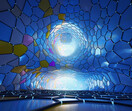Winners
The Computer Graphics Forum 2024 Cover Image has been selected by the CGF editorial board. We thanks all people who submitted this year, and hope that they will participate to the next year contest.
Winner of the Computer Graphics Forum 2024 Cover Image Contest

Dennis Bukenberger
TU Munich
.
This image shows the inside of the teaser figure 'fertility' from Polygon Laplacian Made Robust [1]. It visualizes the condition numbers of individual polygon stiffness matrices. The mesh transitions from the input mesh to our result from left to right. The original mesh features disfigured polygons with alarming (yellow) or terrible (magenta) condition numbers. With our tailored smoothing algorithm, polygons become very regular and, combined with our improved polygon Laplacian, result in better condition numbers (blue) and improved robustness in computational simulation. Blender was used to stylize the geometry and render the image.
Second place(ex aequo):

Dennis Bukenberger
TU Munich
Inspired by the box jellyfish, this image vividly captures the essence of our hex-meshing procedure.
Transformed into a cubic marvel, the box jellyfish is gracefully floating amidst integer grid lines.
Metaphorical for the apparent contradiction of merciless mathematical precision and natural organic shapes, the jellyfish is bathed in a rainbow surrounded by clouds in the sky while simultaneously submerged underwater, with sunlight sparkling on the water surface above.
In the cubic spirit, appendages align with global coordinate axes and the virtual camera uses four blades for a square-shaped bokeh.
Without post-processing, the image composition is completely realized "in-camera" with blender.

Mengqi Xia (1), Bruce Walter (2), Christophe Hery (3), Olivier Maury (3), Eric Michielssen (4) and Steve Marschner (2)
(1) EPFL
(2) Cornell University
(3) Meta
(4) University of Michigan
Hair and fur exhibit glinty color noise under sharp illumination; they can exhibit a slight hue shift even from a distance. To model these effects and produce the first fully 3D wave scattering model for rough fibers, we developed a 3D wave simulator based on a physical optics (PO) approximation to predict surface reflection and diffraction from rough fibers. We then developed a practical wave optics fiber model based on a noise representation that captures the statistical properties of the speckle patterns generated by rough fibers. Our practical model makes it possible to incorporate the important colorful glint effect for production hair and fur rendering.
Third place:

Petros Tzathas (1), Boris Gailleton (2), Philippe Steer (3) and Guillaume Cordonnier (1)
(1) Inria, Université Côte d’Azur
(2) Univ Rennes, CNRS, Géosciences Rennes, UMR 6118
(3) Univ Rennes, CNRS, Géosciences Rennes, UMR 6118, Institut Universitaire de France
This image shows a canyon carved on an escarpment by fluvial erosion, modeled with the Stream Power Law (SPL) - a fluvial erosion law borrowed from geomorphology. We obtained the geometry of the terrain from a new algorithm based on analytical solutions of the SPL, which directly provide an eroded terrain at a given time without requiring a lengthy simulation of the geological past. We used Terragen for texturing and rendering.
